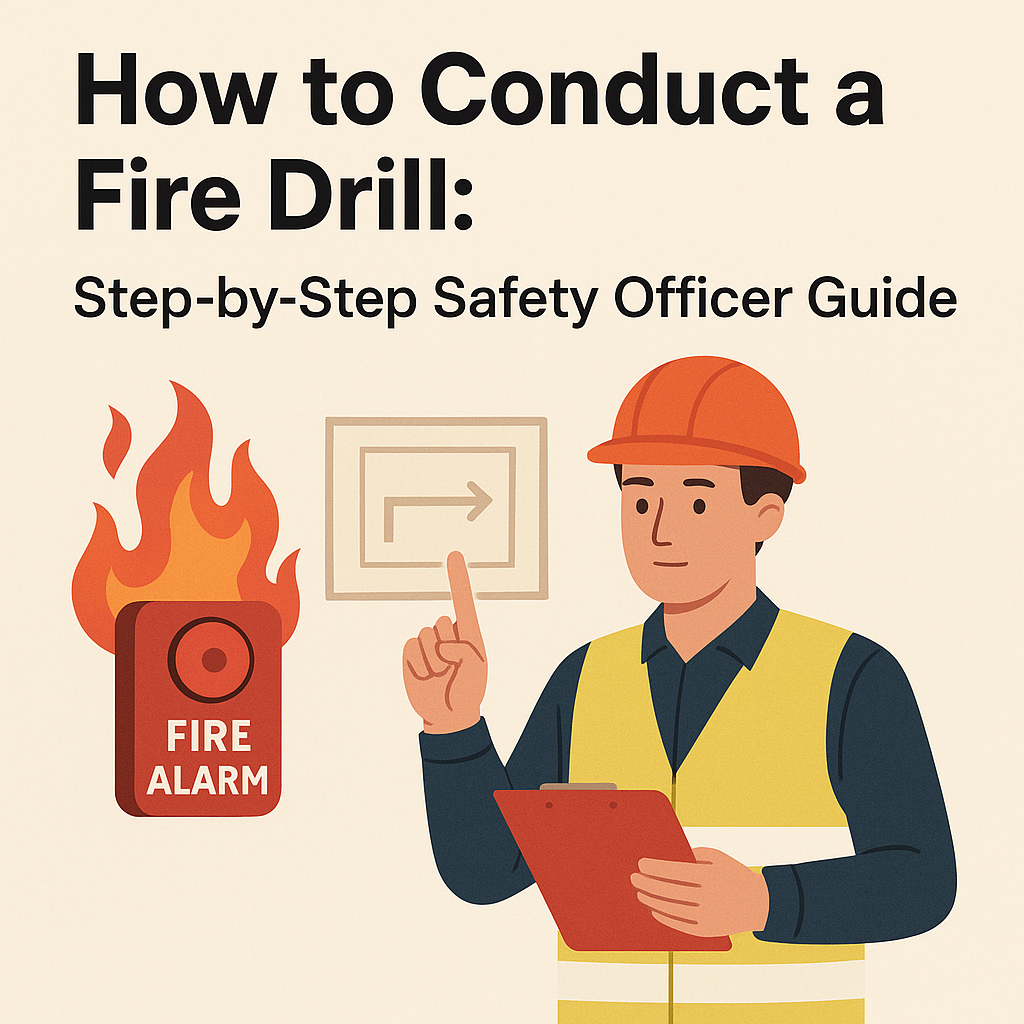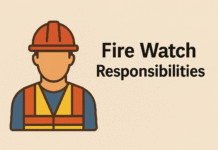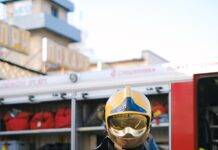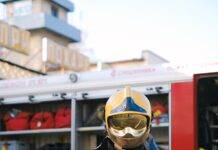
How to Conduct a Fire Drill: Step-by-Step Safety Officer Guide
Imagine this: a fire breaks out, alarms blare, and people are scrambling in every direction. Chaos? Yes. Avoidable? Absolutely! That’s where a well-executed fire drill comes in. As a Safety Officer, your job isn’t just to make people aware—it’s to make them act fast, think smart, and stay safe.
Let’s dive into a step-by-step guide on how to conduct a fire drill that could literally save lives.
Understanding Fire Drill Objectives
Saving Lives Through Preparedness
Fire drills create muscle memory. When people practice evacuating regularly, they respond instinctively during real emergencies.
Minimizing Panic and Confusion
Training reduces fear. When everyone knows what to do, panic turns into purpose.
Testing Emergency Systems and Plans
Want to know if your alarms work? Or if your escape routes are practical? Drills uncover these crucial answers.
Legal and Compliance Considerations
Fire Safety Laws and Standards
Most countries have fire safety codes (like NFPA in the U.S. or NBC in India). You’re often legally required to conduct drills.
Industry-Specific Guidelines
For example, hospitals and schools often have stricter drill requirements than corporate offices. Know your standards.
Planning the Fire Drill
Set Objectives for the Drill
Is this a basic evacuation? Or a full-scale emergency response test? Set clear goals before you begin.
Choose a Date and Time
Avoid lunch breaks or critical operations unless you’re testing worst-case scenarios.
Form a Fire Safety Committee
Include HR, maintenance, department heads, and emergency response team members.
Preparing the Emergency Evacuation Plan
Evacuation Routes and Maps
Ensure all escape routes are marked, clear, and visible. Maps should be posted in common areas.
Designated Assembly Points
Choose safe, open areas away from the building where people gather after evacuating.
Roles and Responsibilities
Assign fire wardens, sweepers (who check all rooms), and first aid personnel.
Communication is Key
Informing Employees in Advance (or not)
Announced drills allow practice; unannounced ones test real readiness. Mix them up.
Using Fire Alarms and Announcements
Test the alarm system and ensure the PA system clearly guides people during drills.
Conducting the Fire Drill
Activate the Fire Alarm
Let the drill begin! Start with triggering the alarm to simulate a real situation.
Observe Behavior and Movement
Watch how people react. Are they calm? Are exits being used properly?
Time the Evacuation
Measure the time from alarm to final headcount. Set benchmarks for improvement.
Monitoring & Supervising the Drill
Marshals and Floor Wardens
They guide people, assist with special needs, and report floor clearance status.
Safety Officer Observation Points
Stand at strategic areas to see flow issues, bottlenecks, and unsafe behavior.
Ensuring Everyone is Accounted For
Use checklists or roll calls at the assembly point. No one should be left behind.
Post-Drill Evaluation
Conduct a Headcount
Ensure every employee and visitor is accounted for. Compare with attendance records.
Gather Feedback
Ask staff what worked and what didn’t. You’ll gain insights you might miss as an observer.
Identify Gaps and Delays
Were certain exits blocked? Did someone freeze in panic? Fix these issues immediately.
Training and Retraining Employees
Addressing Mistakes and Delays
Hold quick refresher sessions to correct behaviors like grabbing personal items or using elevators.
Drills for Special Needs Personnel
Ensure personalized evacuation plans for disabled staff, pregnant women, or the elderly.
Documentation and Reporting
Writing a Fire Drill Report
Include time of evacuation, issues found, lessons learned, and corrective actions.
Keeping Records for Audit
Maintain reports for at least 2–3 years. Auditors and fire inspectors will ask for them.
Example Fire Drill Scenario – Office Building Fire Drill
Scenario: You are the Safety Officer of a 6-floor office building with approximately 120 employees. You plan to conduct a semi-annual fire drill.
Step-by-Step Execution of the Fire Drill
1. Planning Phase
- Objective: Test evacuation time and employee response.
- Date/Time: Scheduled for 11:00 AM, Tuesday.
- Team Setup:
- 6 floor wardens (one per floor)
- 2 fire marshals
- 1 assembly point coordinator
2. Pre-Drill Preparation
- Evacuation Maps: Updated and posted near elevators and exits.
- Assembly Point: Marked 100 meters from the main entrance.
- Communication:
- Email sent to staff 2 days before the drill (as it’s a planned drill).
- Building security and facility team notified.
3. Drill Execution
- 11:00 AM: Fire alarm is manually activated by Safety Officer.
- Employees begin evacuating through stairwells.
- Floor wardens:
- Sweep all restrooms and meeting rooms.
- Assist anyone with mobility issues.
- Fire marshals monitor exit doors to ensure no return inside.
4. At the Assembly Point
- Headcount is conducted using attendance logs.
- 118 out of 120 employees accounted for.
- Safety Officer radios floor wardens to check for the 2 missing staff.
5. Post-Drill Debrief
- Time Taken: 4 minutes 30 seconds.
- Issue Identified: Two employees used the elevator.
- Solution: Refresher training scheduled to reinforce evacuation protocol.
6. Documentation
- Fire drill report written.
- Includes date, time, participants, evacuation time, problems, corrective actions.
- Report shared with management and retained for audit.
Common Mistakes to Avoid
Not Taking It Seriously
Employees might treat it like a break. Make them understand it’s life-saving practice.
Poor Communication
Lack of instruction during drills leads to chaos. Always be clear and loud.
Ignoring Feedback
Feedback is a goldmine. Don’t overlook it—improve with each drill.
Frequency of Fire Drills
How Often Should Fire Drills Be Conducted?
Best practice: once every 6 months. High-risk areas? Every quarter or monthly.
Adapting Drill Frequency for Different Workplaces
Factories, hospitals, or chemical plants might need more frequent drills than a corporate office.
Real-Life Scenarios and Lessons Learned
Case Study 1 – Manufacturing Plant
After a drill, workers realized one emergency exit was blocked by inventory—this was fixed immediately.
Case Study 2 – Office Building
An employee with hearing impairment missed the alarm. A visual strobe was installed after the drill.
Using Technology for Better Fire Drills
Fire Drill Apps and Software
Tools like SafetyCulture or Evacuation Management Systems help automate reporting and checklists.
Real-Time Communication Tools
Use walkie-talkies, WhatsApp groups, or PA systems to coordinate marshals and updates during the drill.
Conclusion
A fire drill is more than just a routine—it’s a life-saving rehearsal. As a Safety Officer, your role is to lead from the front, fix what’s broken, and empower every person in the building to protect themselves. Remember, the goal isn’t perfection on the first try—it’s progress with every drill.
National Fire Service Day 2025: History, Significance, and Key Facts
Emergency Preparedness: Fire Safety, Evacuation Plans, and First Aid
Fire Prevention vs Fire Suppression: What’s More Important?
Fire Safety Interview: 50 Questions and Sample Answers
How to Conduct a Fire Drill at Work?
FAQs
1. How long should a fire drill take?
Ideally, from alarm to assembly, under 5 minutes. However, this may vary based on building size and number of people.
2. Can a fire drill be unannounced?
Yes! Surprise drills test real-world reactions and highlight weaknesses better than pre-informed ones.
3. What if someone refuses to evacuate during a drill?
Treat it as a learning opportunity. Provide training on the importance of evacuation and document the refusal.
4. How do I conduct fire drills in a high-rise building?
Use phased evacuations, stairwells, floor wardens, and elevator shutdown procedures. Practice safe and orderly movement.
5. Are fire drills mandatory by law?
In most regions, yes. Always refer to your local fire safety codes or OSHA/ISO guidelines to stay compliant.
























